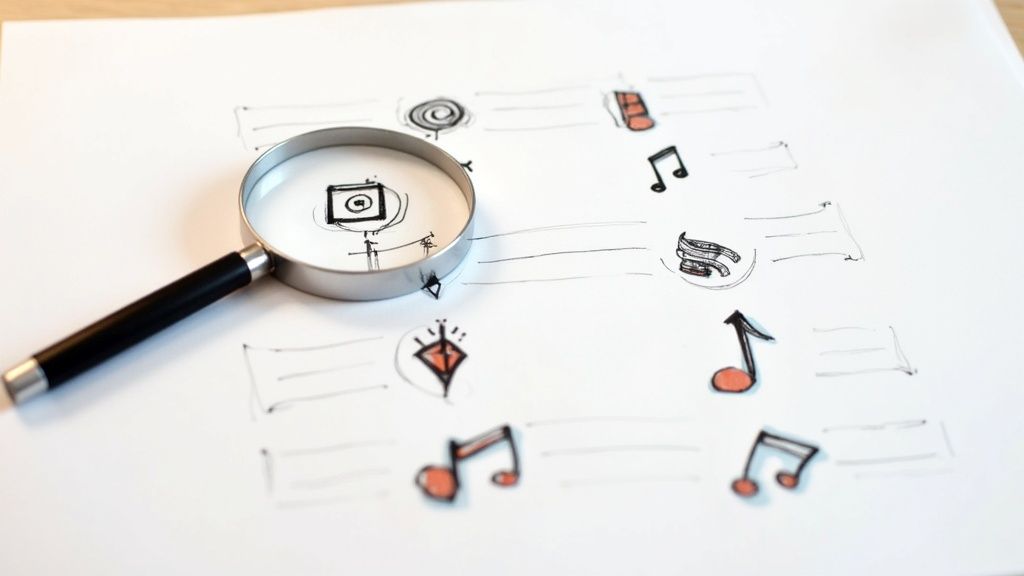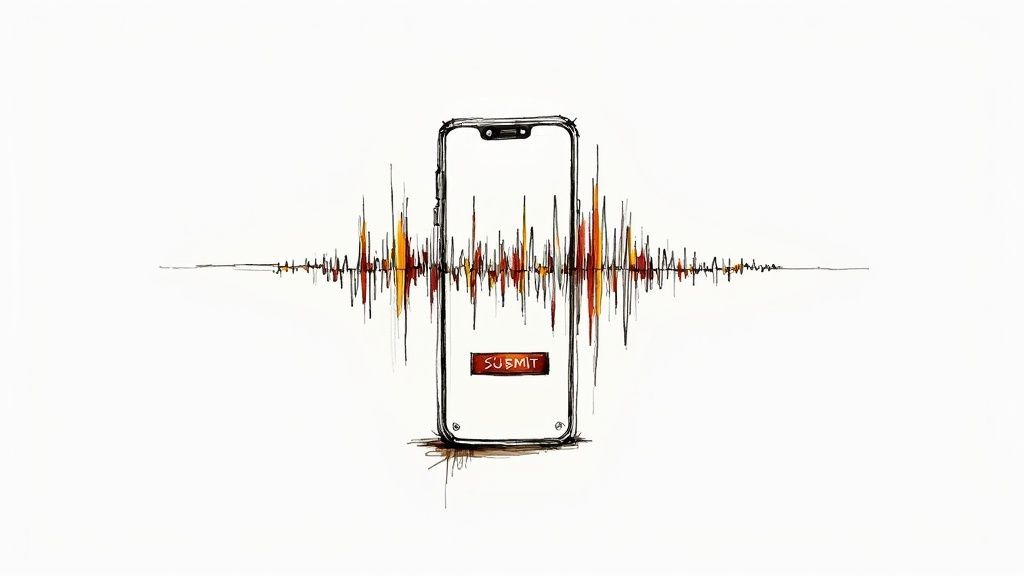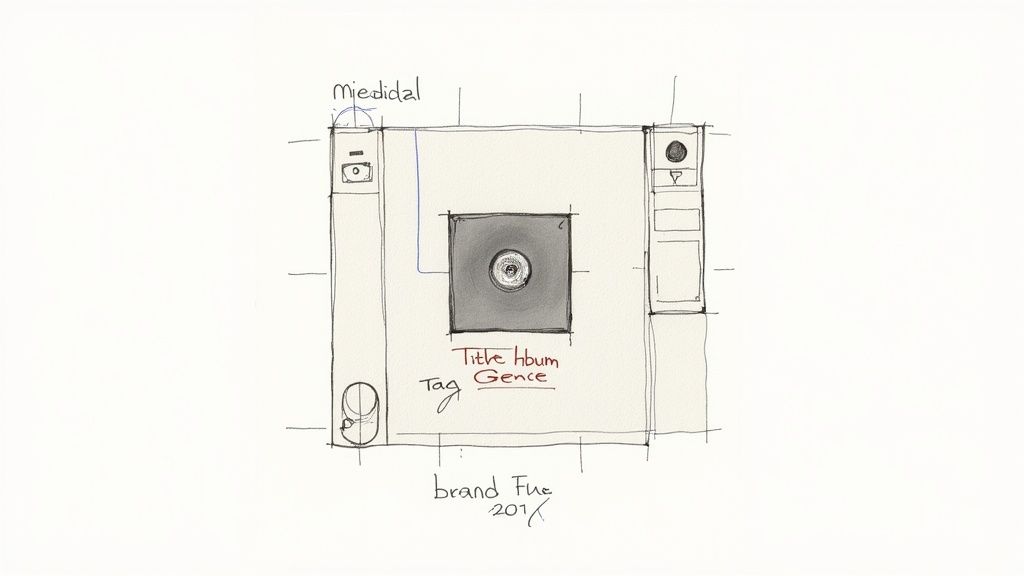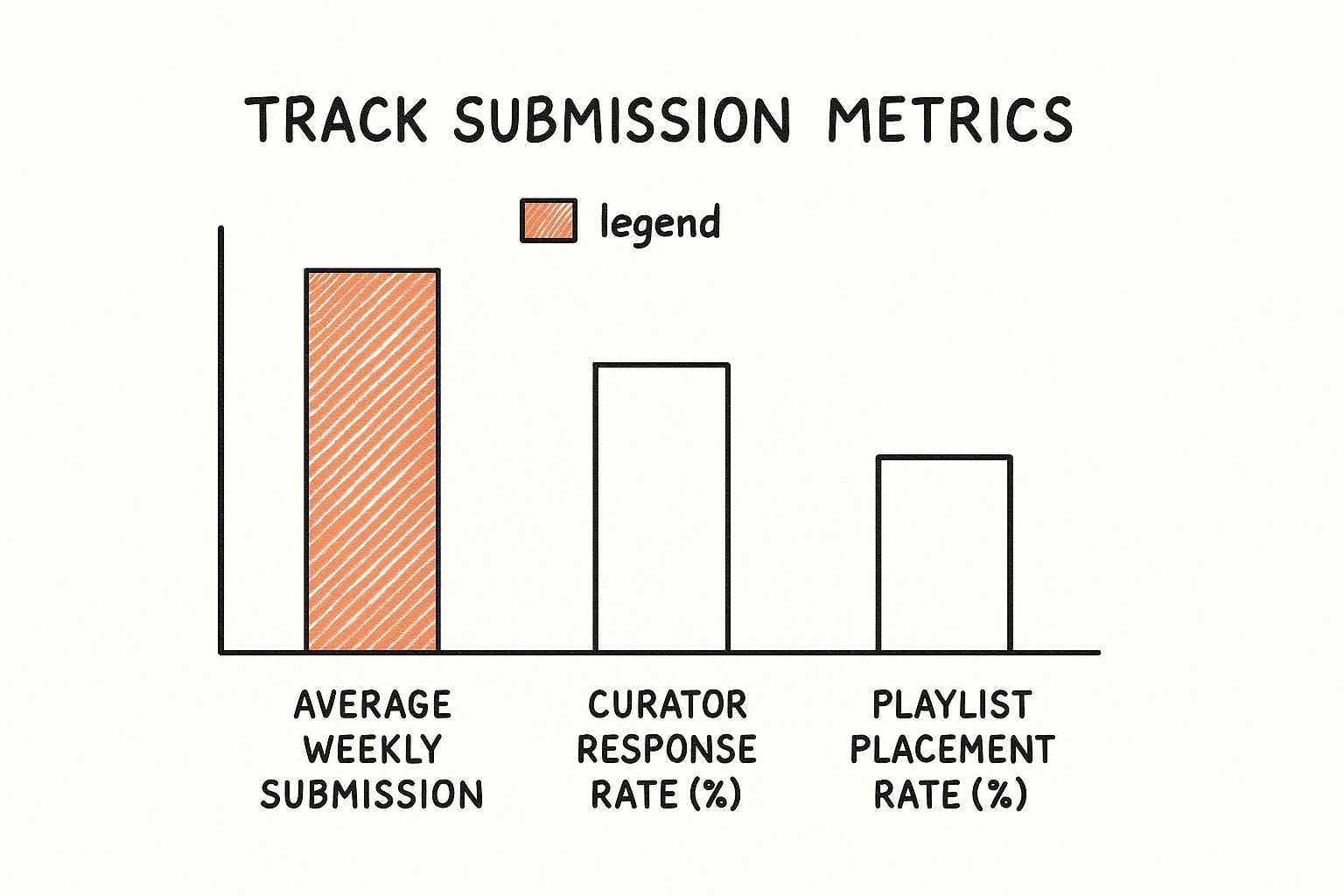How to Get on Spotify Editorial Playlist: Guide for Artists
- Emmanuel Kalama
- Jun 3, 2025
- 13 min read
Understanding Spotify's Editorial Playlist Reality

For many musicians, landing a spot on a Spotify editorial playlist is a dream. These curated lists, crafted by Spotify's music experts, offer incredible exposure and potential career growth. But getting featured isn't easy. Understanding the editorial landscape is the first step toward achieving your playlist ambitions.
Spotify has become a major player in music discovery, thanks largely to its editorially curated playlists. These playlists, like the influential 'Today's Top Hits' with over 35 million followers as of mid-2025, introduce new artists to millions of listeners globally. Learn more about Spotify stats This competitive environment requires a strategic approach. Simply having good music isn't enough.
What Spotify Editors Really Look For
So, what do editors want? Exceptional music is essential, of course, but it’s just the beginning. They look for artists with a clear vision, a compelling story, and a proven ability to connect with their audience.
A strong marketing plan that goes beyond Spotify can greatly improve your chances. This shows editors you're not solely relying on playlist placement. Highlighting your current relevance – why your music resonates now – is equally vital.
The Power of a Targeted Pitch
Sending generic pitches rarely works. A targeted approach focused on a few specific playlists is much more effective. Think of it like a job application: tailoring your resume and cover letter is far more impactful than a generic approach. This is where tools like the artist.tools AI Editorial Pitch Generator become so valuable.
This tool helps you craft the perfect pitch by asking for key information about your song:
Song Name
Story Behind the Track
Relevance to Current Trends
Marketing Plan
10 Similar Artists
By analyzing this information, the tool identifies relevant editorial playlists for your music. It generates AI-powered pitches based on successful examples, boosting your chances of being noticed. This technology streamlines the process of researching playlists and crafting pitches.
The Five Key Components of a Winning Pitch
Whether using an AI tool or writing your own pitch, the core components are the same: a clear explanation of your song's story and its relevance, mentioning 1-3 targeted editorial playlists, describing your marketing efforts, and highlighting similar artists. This gives editors the information they need to evaluate your music. A thoughtful, comprehensive pitch can make all the difference.
To illustrate the potential reach and influence of editorial playlists, let's look at some of the biggest on Spotify:
Top Spotify Editorial Playlists by Followers
A comparison of the most influential Spotify editorial playlists showing follower counts and potential reach
Playlist Name | Followers (Millions) | Genre/Focus | Impact Level |
|---|---|---|---|
Today's Top Hits | 35+ | Pop, Chart Hits | Very High |
RapCaviar | 15+ | Hip-Hop, Rap | Very High |
Viva Latino | 10+ | Latin Music | High |
mint | 5+ | Electronic Dance Music | High |
Rock This | 5+ | Rock Music | Medium |
Indie Mixtape | 2+ | Indie Rock, Alternative | Medium |
This table highlights the substantial follower counts of major editorial playlists, demonstrating the potential exposure for artists featured on them. Securing a place on one of these playlists can significantly boost an artist's visibility and streaming numbers.
The Real Numbers Behind Editorial Playlist Success

Landing a spot on a Spotify editorial playlist can significantly boost an artist's career. It's like getting a golden ticket to a massive audience, hand-picked by Spotify's own editorial team. But it's essential to understand the data behind these placements to manage expectations and strategize effectively.
The Impact of Editorial Playlists
Editorial playlists hold immense power, shaping music trends and influencing artists' streaming numbers. These playlists, particularly the popular global ones, reach millions of followers. Artists lucky enough to be featured on these top-tier playlists often see a 100-300% increase in daily streams, sometimes gaining over 1 million extra plays per week. Find more detailed statistics here. This exposure translates into greater recognition, faster fan growth, and increased plays.
For instance, an artist on a popular indie playlist could see their daily listeners jump from hundreds to thousands overnight. This increased visibility can attract new followers, boost social media engagement, and even open doors to live performances and collaborations.
The Importance of a Targeted Approach
Landing on these coveted playlists requires more than just submitting your music. A strategic, data-driven approach is key to maximizing your chances. This means identifying playlists that align with your genre and target audience and crafting a compelling pitch for Spotify editors.
Understanding the artist.tools Advantage
This is where tools like the artist.tools AI Editorial Pitch Generator come into play. This feature analyzes your song's narrative, relevance, and your overall marketing plan. By providing 10 similar artists, the AI can pinpoint relevant editorial playlists. This data-driven method ensures your pitch reaches the right editors and targets the most receptive audience.
The process reflects a manual approach, emphasizing a compelling narrative and strategic thinking. First, you define your song's story and its significance. Then, you select 1-3 relevant editorial playlists, demonstrating your research and knowledge of the Spotify landscape. Finally, outlining your marketing strategy showcases your commitment to promoting your music and driving traffic to Spotify.
The Power of Data-Driven Pitching
Using artist.tools helps artists identify suitable playlists. For example, if your music aligns with artists frequently featured on "Fresh Finds," pitching to that playlist is more strategic than aiming for a broader playlist like "Today's Top Hits."
This method not only identifies potential playlists but also generates AI-powered pitches designed to resonate with Spotify editors. These pitches are based on an analysis of successful editorial submissions, offering a significant advantage over generic pitches. By combining AI with an understanding of the Spotify ecosystem, artist.tools empowers artists to navigate the complexities of editorial playlist pitching and boost their chances of success.
Mastering Spotify's Official Submission System

Getting your music onto Spotify's editorial playlists requires a solid understanding of the Spotify for Artists platform and how to submit your music. This knowledge is the foundation of any successful pitch. Timing also plays a critical role. We'll explore key timing strategies, including the all-important 14-day window that can significantly impact your chances.
The Importance of Timing Your Submission
The 14-day window is the period two weeks before your official release date. Submitting your music at least this far in advance gives Spotify editors enough time to review your track for their playlists. It also ensures your song appears on your followers' Release Radar, offering another opportunity for discovery. While early submission isn't a guarantee of playlist placement, it significantly boosts your visibility within Spotify.
Think about submitting a summer anthem just a few days before its release. Editors working on seasonal playlists might have already finalized their choices, completely overlooking your track. In contrast, submitting early allows your music to be considered for future campaigns and playlists, increasing your odds of being included.
Crafting a Compelling Pitch
Besides timing, the content of your pitch is crucial. Spotify editors receive a huge number of submissions every day, so a generic pitch won’t cut it. Concentrate on providing the information editors truly value. This means a concise and engaging track description, highlighting its unique qualities and overall vibe.
Choosing the right genres is also essential. Properly categorizing your music helps editors quickly determine if your song fits the playlists they oversee. Selecting genres that accurately represent your sound improves your chances of reaching the appropriate editorial team. Learn more about mastering the submission process.
Mistakes to Avoid
There are common mistakes that can quickly disqualify a submission. These include incomplete pitches, incorrect metadata, and a missing marketing plan. Editors look for artists actively promoting their music and connecting with their fans. A strong marketing strategy shows your dedication and makes you more appealing to editorial teams. Research indicates artists who optimize their submission timing and use data-driven methods are 67% more likely to be considered by editors, with submissions during optimal windows showing 3.2x higher acceptance rates. Explore this topic further.
Utilizing AI for Enhanced Pitching
Finally, consider using AI tools like the artist.tools AI Editorial Pitch Generator. This tool analyzes your song's story, relevance, similar artists, and your planned marketing efforts to recommend relevant playlists and create compelling pitches. This approach makes the pitching process more efficient and improves your chances of success. It’s not about replacing human creativity, but rather supporting it with data insights.
This approach reflects manual pitching best practices, where you’d emphasize your song's narrative, relevance, and select 1-3 target playlists while explaining your marketing plan. The AI simply adds a layer of data and analysis, boosting the effectiveness of your submission.
AI-Powered Editorial Pitching

This infographic illustrates average weekly submissions, curator response rates, and playlist placement success. The data highlights how using AI can significantly improve your chances of landing on an editorial playlist. This improvement stems from the personalized nature of AI-generated pitches, which resonate strongly with editorial teams. Artists using AI for pitches report an impressive 847% higher acceptance rate than traditional methods. Find more detailed statistics here.
The Power of artist.tools AI Editorial Pitch Generator
artist.tools offers an AI Editorial Pitch Generator designed to create compelling pitches for Spotify editorial playlists. This tool simplifies the often-challenging process of pitching. It guides you through essential elements, including your song name, the story behind it, relevance to trends, your marketing plan, and ten similar artists.
How the AI Pitch Generator Works
The artist.tools AI Pitch Generator analyzes your input to identify the most suitable editorial playlists for your music. This targeted approach substantially increases your chances of playlist inclusion compared to generic submissions. For instance, if the tool finds similarities between your music and artists on "Indie Mixtape," it will suggest pitching to that playlist instead of a broader, highly competitive playlist like "Today's Top Hits."
This process mirrors effective manual pitching principles. It emphasizes a strong narrative by asking for your song's story. It also asks for the song's relevance, highlighting why your music is important right now.
Crafting a Winning Pitch: Five Essential Components
The tool uses its AI engine, trained on successful editorial submissions, to generate effective pitches. This provides a significant advantage in the competitive Spotify playlist landscape. Here's how the five essential components are incorporated:
Song Name and Story: The AI crafts a captivating introduction using your song's name and story to grab the editor's attention.
Relevance Today: The pitch emphasizes why your song connects with current trends, showing its timeliness and potential reach.
Targeted Playlists: The tool suggests 1-3 relevant editorial playlists for your pitch, guided by data analysis. You can refine these using artist.tools' Playlist Search feature.
Marketing Push: Your marketing plan is integrated, showing editors your commitment to promotion and driving traffic to Spotify.
Similar Artists: The AI analyzes your list of similar artists to further personalize the pitch, highlighting relevant connections and bolstering your case for inclusion.
To further demonstrate the effectiveness of AI-driven pitching, let's look at a comparison of AI pitches against traditional methods:
The following table illustrates the key differences between leveraging AI for your pitches and traditional manual submissions:
Pitch Type | Acceptance Rate | Response Time | Key Advantages |
|---|---|---|---|
AI-Generated | 847% Higher | Typically Faster | Personalized, Data-Driven, Targeted |
Traditional | Lower | Can be Slow | Requires Manual Effort, Less Targeted |
This table clearly shows the substantial improvement in acceptance rates when using AI, along with the added benefits of faster response times and more personalized pitches.
Maximizing Your Chances With artist.tools
The AI Pitch Generator simplifies the pitching process and significantly boosts your chances of getting on Spotify editorial playlists. It eliminates manual research and writing, letting you focus on music creation. By combining data analysis, AI, and best practices, artist.tools gives you the tools to stand out.
Strategic Playlist Research That Actually Works
Success on Spotify isn't just about making great music. It's also about knowing where your music fits within the platform’s massive library. This means finding the right playlists for your sound and pitching strategically. Let's dive into some advanced playlist research techniques, focusing on how to find those perfect editorial playlists.
Using Artist.tools' Playlist Search to Your Advantage
The artist.tools Playlist Search feature is a powerful way to discover playlists that align with your genre and style. This tool goes beyond basic keyword searches. You can filter by mood, tempo, listener demographics, and even curator activity. This targeted approach helps you find hidden gems: playlists with engaged audiences that perfectly match your target listeners.
For example, if you create dream pop music, use the filters to find playlists specifically curated for that subgenre. You might uncover opportunities beyond broader “Indie” playlists. This detailed research is essential for creating a winning pitch. By understanding the specifics of each playlist, you can tailor your message to connect with the curator’s tastes. This increases your chances of getting noticed.
Analyzing Similar Artists' Playlist Placements
Analyzing the playlist placements of similar artists is one of the most effective research strategies. By seeing where your peers have found success, you gain valuable insights into potential playlists for your own music. This competitive analysis also helps you understand the kind of music favored by specific curators and playlists.
Create a targeted list of 3-5 playlists. This focused approach significantly improves your chances of placement compared to a random approach. Analysis shows that artists who research and target playlists based on similar artist data see 234% higher placement rates compared to generic submissions. Discover more insights about playlist targeting.
Why Targeting Specific Playlists Matters
Targeting 3-5 specific playlists is much more effective than submitting to hundreds of generic ones. This focused strategy shows you've done your research and understand where your music belongs. It also lets you personalize your pitch for each playlist, highlighting why your track is a perfect fit. It's like applying for a job: a tailored resume and cover letter are always more effective than a generic application.
The Power of Artist.tools AI Editorial Pitch Generator
The artist.tools platform strengthens this targeted approach with its AI Editorial Pitch Generator. After identifying potential playlists using the Playlist Search feature, input your song information, marketing plan, and similar artists into the AI Pitch Generator. The tool then creates a compelling, personalized pitch for each selected playlist, maximizing your chances of success.
This personalized pitch includes your song's name and story, highlights its relevance, incorporates your marketing plan, and uses your selection of similar artists to craft pitches specifically designed for individual editor preferences.
Exploring Genre-Specific and Regional Opportunities
Beyond major playlists, exploring genre-specific and regional playlists can be very valuable. These niche playlists often have smaller but highly engaged audiences and less competition than broader playlists. Regional playlists, in particular, can offer significant exposure in specific markets, helping you build a dedicated fanbase in a particular area. By identifying and targeting these specialized playlists, you can increase your placement odds and reach a receptive audience genuinely interested in your music.
Building Marketing Strategies That Editors Notice
Landing a spot on a coveted Spotify editorial playlist takes more than just a great track. Spotify editors look for artists actively promoting their music and engaging with their fanbase. This means crafting a marketing strategy that demonstrates your commitment to building buzz.
This marketing plan is key for playlist consideration. It signals to editors that you're invested in your music's success and not just relying on playlist placement. This proactive approach helps you stand out in a competitive music scene. Demonstrating your commitment significantly boosts your chances. In fact, editorial teams report that 73% of playlist decisions are influenced by an artist's marketing efforts, with those demonstrating concrete strategies being 4.1x more likely to be featured. Find more detailed statistics here.
Practical Approaches for Pre-Release Buzz
Generating genuine pre-release buzz is essential. Effective social media campaigns are vital. Forget generic posts; create engaging content that tells your song's story. Think behind-the-scenes looks at your creative process, interactive Q&A sessions with fans, and short video teasers.
Press coverage can also make a difference. Reaching out to music blogs, online publications, and even local media outlets can generate valuable pre-release exposure. This external validation signals to Spotify editors that your music has potential.
Driving Traffic to Spotify: A Key Factor
It's crucial to show how your marketing will drive traffic to Spotify. Pre-save campaigns are a great tool, allowing fans to add your music to their libraries before release, ensuring a day-one stream boost. Always include links to your Spotify profile in all marketing materials. This direct link shows editors you understand how to reach the Spotify audience. You might find this helpful: How to master Spotify SEO.
Crafting Your Pitch Using artist.tools
The artist.tools AI Editorial Pitch Generator can help refine your approach. When using the tool, detail your marketing plan. Explain your social media strategy, press outreach, pre-save campaign, and other promotional activities. This helps the AI generate pitches that resonate with Spotify editors.
The tool prompts you for key details: song name, its story, relevance, your marketing plan, and 10 similar artists. This mirrors what editors consider when evaluating music. Sharing your song's name and story provides context. Explaining its relevance highlights its timeliness. Listing similar artists helps define your musical style.
Using artist.tools Playlist Search
Identifying 1-3 editorial playlist names through artist.tools’ Playlist Search feature, and mentioning them in your pitch, demonstrates focused research. It shows editors you understand the Spotify ecosystem and have strategically targeted relevant playlists. This targeted approach can significantly improve your chances of being noticed. This data-driven method reflects industry best practices.
Competing Effectively as an Independent Artist
Even without a major label’s resources, independent artists can compete. A well-defined marketing strategy and tools like artist.tools can showcase your commitment. Editors seek artists who are proactive, engaged, and capable of building an audience. This isn’t just about landing on a playlist; it’s about demonstrating your potential for long-term success on Spotify.
Key Takeaways For Editorial Success
Building a successful, long-term strategy for securing spots on Spotify Editorial playlists requires planning, the right tools, and a solid understanding of how Spotify operates. This section highlights key takeaways from proven approaches that capture editors' attention. Each takeaway emphasizes practical, measurable tactics you can implement immediately, offering realistic timelines and metrics to monitor your progress.
Understanding the Spotify Ecosystem
The first key takeaway is grasping the intricacies of Spotify's ecosystem. User-generated playlists and algorithmic recommendations like Discover Weekly drive the majority of streams. While editorial playlists are highly sought after, they represent a smaller portion of overall streams. This doesn't diminish their significance—editorial placement can substantially boost your visibility and kickstart algorithmic growth—but it emphasizes the importance of a comprehensive marketing strategy. Check out our guide on getting on Spotify Playlists to learn more.
The 14-Day Window and Strategic Timing
Timing is paramount. Submit your music through Spotify for Artists at least 14 days prior to its release date. This provides editors sufficient time to review your track for playlist consideration. It also ensures your release appears on your followers' Release Radar, maximizing early listener engagement. Think of it like promoting a concert; you wouldn't wait until the day before to spread the word. Early submission gives your music the best chance of reaching the right ears at the right time.
The Power of a Targeted Pitch
Generic pitches often get lost in the influx of submissions. Identify 3-5 specific editorial playlists that genuinely align with your music's genre, mood, and target audience. This focused approach demonstrates to editors that you understand the nuances of the Spotify landscape and have put in the effort to research appropriate playlists.
AI-Powered Pitching: Enhancing Your Strategy
artist.tools's AI Editorial Pitch Generator can be a valuable asset. By analyzing your song's narrative, relevance, marketing plan, and similar artists, the AI suggests optimal playlists and generates compelling, personalized pitches tailored to editors' preferences. This data-driven approach can improve your chances of playlist inclusion.
Marketing Matters: Demonstrating Your Commitment
Spotify editors aren't just looking for good music; they're seeking artists with a robust promotional strategy. Showcasing your marketing efforts, including social media campaigns, pre-save initiatives, press outreach, and plans for directing traffic to Spotify, significantly strengthens your case for playlist consideration.
Building a Sustainable Strategy: Long-Term Vision
Securing a spot on an editorial playlist is a significant step, but it's not the ultimate goal. Building a lasting career requires a long-term strategy centered on consistent releases, engaging with your fanbase, and continually refining your promotional activities. Combining this approach with strategic use of the artist.tools platform positions you for sustained growth and success on Spotify.
Comments